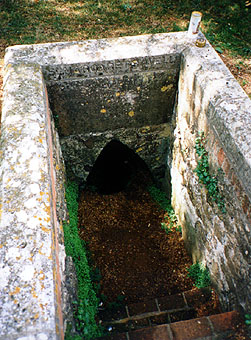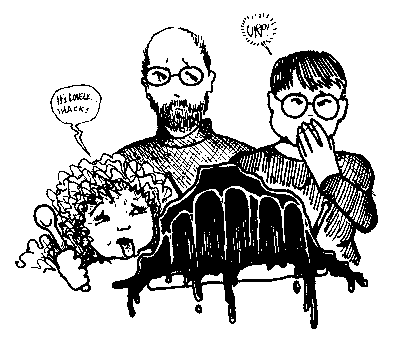
A hole in the ground
Back in the normal Plokta world of careful research and historical accuracy, Alison offers you...
For as long as I can remember, my mother has owned the same tin of black treacle. Every year of my childhood, sometime around Bonfire Night, she would be overcome by the urge to make gingerbread or parkin or some similar. This involved delving into the deepest recesses of the kitchen cupboard, rooting out the black treacle, adding a tablespoon of foul black gunge to the mixture, and returning the tin to the darkness from whence it came. I remember the tin clearly; a green tin of Fowlers' West India Treacle, slightly rusty, and extremely sticky from decades of encrusted lumps of treacle building up on the outside. Every year, it left a new sticky black ring on the cupboard shelves, and in this manner its age could be accurately assessed.
Though I liked parkin and gingerbread well enough, I always thought that black treacle tasted horrible. I found this confusing, because I have always been very fond of treacle tarts and treacle puddings. My father would explain gravely that the ambrosial active ingredient of treacle tarts, treacle puddings and flapjack was golden syrup, and not treacle at all. We were wrong to call it treacle; the term should be reserved strictly for unrefined cane molasses, the black gunge found at the bottom of the sugar factory after all the sugar has been removed.
I knew, of course, that in reality treacle came from treacle wells. My father was careful to ensure that we were educated children, and read us the works of Lewis Carroll. In Alice's Adventures in Wonderland, the Dormouse tells of three little girls who live at the bottom of a treacle well. They were learning to draw, he explains. Presumably they were learning to draw treacle; the stuff is so stiff and difficult to work with that 'drawing treacle' is an English metaphor for any slow and frustrating task. Alice complains that there is no such thing as a treacle well.
But she was wrong. Indeed, the three little girls were modelled on the real Alice Liddell and her sisters, who used to visit a treacle well at St. Margaret's Church, in Binsey, near Oxford. The treacle from this well had been noted for centuries as a cure for eye problems. In the eighth century, St. Frideswide, the patron saint of Oxford, appealed for divine intervention to help cure the king's blindness. The treacle well duly appeared, Frideswide cured the king (who had been struck blind in the first place because of his lascivious pursuit of the virginal saint), and the well and its treacle were famed throughout, well, Oxford. So the treacle well has been there for over a thousand years; probably longer than the tin of treacle has been in my mother's cupboard.

A hole in the ground
Nowadays the well is really only a hole in the ground. However, Christchurch cathedral in Oxford has a number of stained glass windows, designed by Burne-Jones and depicting the life of St. Frideswide. One of these shows Frideswide healing the king at the Binsey treacle well.

St Frideswide lays on the treacle
All of this seems more plausible once you know that a treacle was originally a medicinal compound (though probably not Lily the Pink's medicinal compound). It only came to mean the thick syrup later, after a particularly sweet medicinal compound, the treacle of Venice, cornered the market. Mind you, it has been believed for thousands of years that the nastier something tastes, the better it is for you. If this is true, then black treacle must be very medicinal indeed. And holy wells with particularly vile water were known as treacle wells. The lack of actual treacle has not prevented the practice of sending Oxford freshers to draw treacle from the treacle well. I asked Steven about this, but his memories of that night are hazy.
All of this came to mind the other day, when I bought a tin of black treacle. I had not bought it to cure my eye problems, although these have been terrible recently, due to Marianne's pastime of grabbing my glasses from my face and slinging them violently across the room. I'd bought it because I got a new cookbook, which included a recipe for black treacle jelly. I'd never had black treacle jelly, and it looked interesting. Pam Wells was coming round the following day, and we thought she would make a plausible guinea pig. Not only that, but we'd try out the jelly on her.
Pulling the tin of treacle from the cupboard, I noticed it had a best before date. 'That's funny,' I thought. 'Black treacle never used to have a best before date. My mother's tin of black treacle, which she keeps in the deepest depths of her cupboard, is older than I am, and I've counted the rings to prove it.' This tin was not quite the same. It was made by Tate & Lyle, was red instead of green, and had a lovely picture of a rotting lion on the front. 'Out of the strong came forth sweetness'. From Judges 14:14, and perhaps the least likely advertising picture and slogan in the history of the world. It also had a warning on the side, saying 'Do not exceed the best before date.' Fair enough, but it went on to add a further warning, roughly to the effect of 'Do not under any circumstances use horrible old sticky cans from deep in the backs of your cupboards which haven't seen the light of day for the best part of twenty years, because there's a jolly good chance they'll explode when you lever the top off with a bent tablespoon.' Gosh. I wondered whether I should ring my mother and warn her of the dreadful risk.
 Of course, my tin of treacle was brand new, so did not suffer from any such problems. I did however have a gelatine disaster. I cannot be trusted with gelatine; it all seems to go cloddy and horrid in lumps whenever I use it. It took three attempts before I finally sorted out the treacle jelly and put it in the fridge to set. Except of course, that it didn't set, and I ended up warming it up, making up more gelatine, and trying to set it again. And again. Eventually, in desperation, I shoved the jelly in the freezer. That set it.
Of course, my tin of treacle was brand new, so did not suffer from any such problems. I did however have a gelatine disaster. I cannot be trusted with gelatine; it all seems to go cloddy and horrid in lumps whenever I use it. It took three attempts before I finally sorted out the treacle jelly and put it in the fridge to set. Except of course, that it didn't set, and I ended up warming it up, making up more gelatine, and trying to set it again. And again. Eventually, in desperation, I shoved the jelly in the freezer. That set it.
When it had reached a state of solid-but-not-actually-frozen, we ate it. I took a bite. It was vile. Pam womanfully nibbled away at it, until I let her off the hook by pronouncing it horrid. Steven pointed out that the reason I didn't like it was because it tasted strongly of black treacle. He suggested that if I hadn't wanted my jelly to taste of black treacle I shouldn't have made black treacle jelly. Which is certainly true. We consoled ourselves with the thought that there is a Chinese proverb to the effect that eating a new food extends your life by forty days. In which case the black treacle jelly was probably worth it.
-- Alison Scott
Visit the Plokta News Network: News and comment for SF fandom